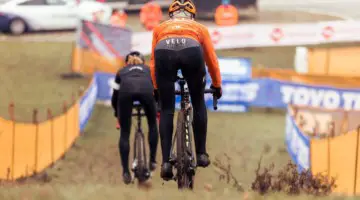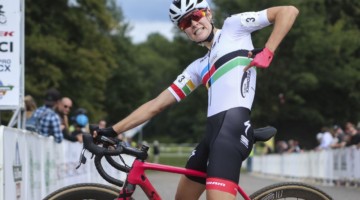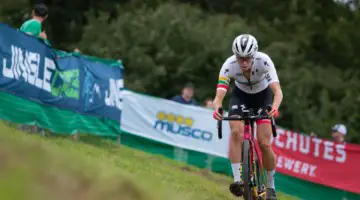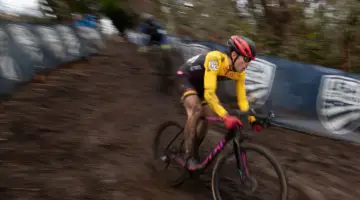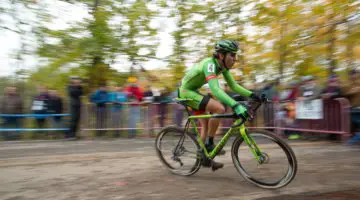This week’s Training Tuesday series article by Chris Mayhew of JBV Coaching focuses on how to handle your actual race after the start whistle blows.
First of all, thank you for reading this column and any of my training columns you’ve read before this. As always, if you have anything you’d like to see covered, please drop me a line (@csmayhew on Twitter being the easiest) and let me know what you’d like to see discussed.
Let’s pick up from my last week’s column on cyclocross race starts. The whistle has been blown, you’re clipped in and going. What should your strategy be to ensure your best possible finish? What should you think about for the rest of your bike race? Like most things it’s easier to break it down into manageable sections and deal with the smaller parts. That way, by the time you know it, you’ve dealt with the whole.
The First Section, The First Selection
So your race has started. The first decision point will come up pretty quickly, roughly a quarter lap into the race. There will be a corner or obstacle that requires a good deal of maneuvering and possibly braking. Typically the first 10 to 15 people or so will make it through cleanly. The rest of the field is going to have to brake hard which usually results in a standstill and maybe some minor crashes.
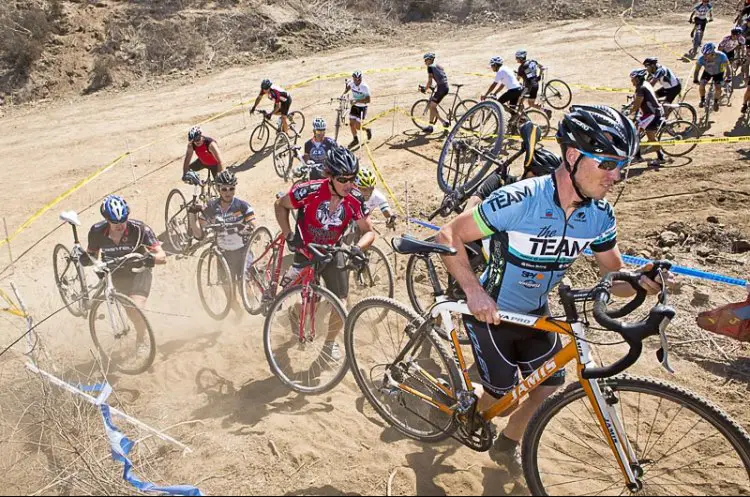
The first feature on the race course might be rideable, but on the first lap, get off early and run past others. photo: Socal Cross file photo, © Phil Beckman/PB Creative
When warming up I suggest finding this spot and watching the races before you if you can. Let them be the crash test dummies. See what works and doesn’t work for them. My most memorable example of this is standing just out of frame watching this happen:
Did you make it through this first section? Great. Just stay where you are and ride with those people for a few more laps. Did you not make it through the section? You’re at decision point number one. The most important thing is to keep moving. So many people will encounter this bottleneck and stand there just straddling their bike or scootering it with one leg. Get off and run Forest run!
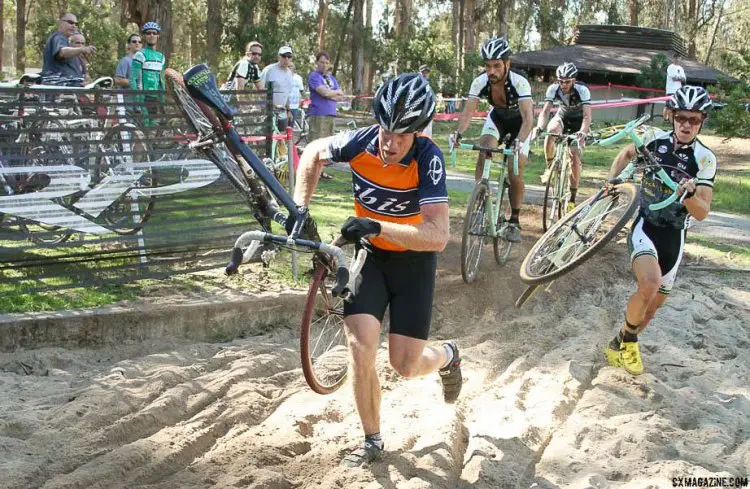
You might find yourself off the bike, outnumbered or with a bobble, but do you know how to react come race day?
photo: Myrah leading Team Rock Lobster, Bay Area Super Prestige. A Men and A Singlespeed. © Cyclocross Magazine
Moving is faster than not moving. If you see people in front of you coming to a standstill or running, be proactive and start running too. Don’t wait till you’re at a dead standstill to figure out Plan B. Keep going and get back on when you can, and when it’s faster than running. A planned dismount is always smoother and faster than an unplanned one, and both are better than coming to a standstill on your bike and falling over.
Now you’re back on the bike and moving again. The race will generally be a long group for a lap or two and then the elastic will snap. Take a look at the Table 1 on this Training Peaks page that details Power Based Training Zones (Coggan Power Zones).
People who are good at Level 7 will be quick in the first 200m. Those who are good at Level 6 will go fast for a lap or so. Those good at Level 5 will do well for about two laps. But what really determines a race is Level 4. So don’t go crazy in the first couple of laps, especially if you’re better at the shorter end of things. You want to save that matchbook for the rest of the race and after about two laps the race will sort itself out to a large extent into small groups of similarly-matched athletes.
Taking Notes, Saving Matches
After the separation happens you’ll often find yourself with two to four other racers. Ride with them for a few laps unless you got a horrendously bad start. Odds are all of you are roughly as fast as each other and throwing haymakers two laps into a race is not what is going to get you ahead of these people. Ride with them and focus on being as smooth as possible. Don’t try and force a separation by being aggressive with your handling or fitness. Accept that this is your group and who you will be riding with for a bit. Start taking notes on where you have an edge over them and where they are sticking it to you. Don’t think of it in terms of your competitors being better than you, or you being worse than them, just notice the differences in riding abilities and take notes as you go around the course.
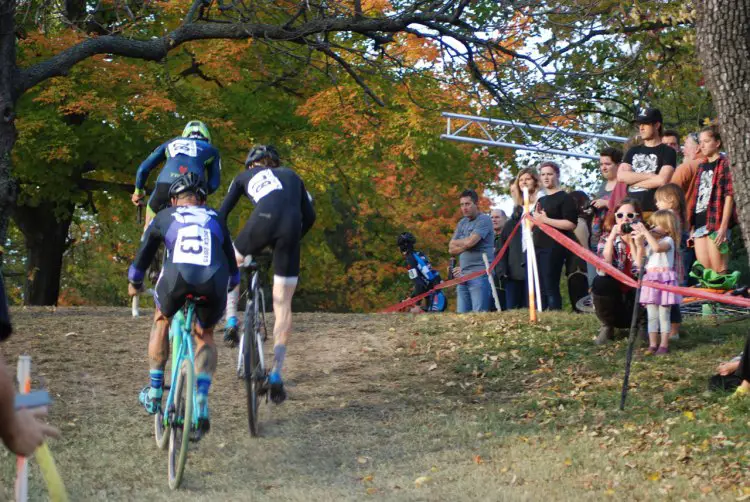
You’ll likely find yourself in a small group after a few laps. Take notes, and save your matches. photo: Day 2 of DCCX, © Neil Schirmer
After a couple of laps of this you, should have a pretty good idea of where you can get a gap and where you are being gapped. With two or three laps to go, it’s time to act on that knowledge. Maybe you’re better on some of the turns. Maybe you’re better on the long flat drags. In the broadest terms, the differences in cyclocross abilities break down to fitness vs. skills. Either will allow you to punch above your weight in a small group when used correctly. Figure out a place that you can put in a small effort to get to the front of the group and then leverage your strength. That could mean attacking the barriers so you can get a clean shot at a long grass drag strip. Or if you’re a stronger technical rider, maybe you attack a few pedal strokes before a technical section and then rip through the corners to open up a gap.
Please don’t waste energy bumping into people in every corner two laps into the race. It’s a pointless expenditure of energy on your part to ride like that. There are those that will argue rubbin’ is racing. And on the last lap, if it’s incidental contact in battling for a podium position, I’d agree with you. On the other hand, I’ve watched Jeremy Powers and Stephen Hyde swap leads six times in six corners with half a lap to go at the Pan Am Championships without making contact. If they can accomplish lead changes cleanly at that level, I’d encourage you to do the same at your level of racing. If nothing else, why engage in that level of negativity when racing? Never mind that if you’re bumping other racers, you’re not going as fast as you could be if you were executing clean fast passes.
The Penultimate Lap
So, it’s two to go, what to do? Work backwards two sections from the finish, and know that you want to be the first one from your group into that section. For instance, a hard corner, then a short steep uphill, then a short pavement sprint. That means you hit the next section with a clean approach, come through that first, and then hit the finish cleanly. So time your attack to take advantage of that sequence of events. In this instance, figure out how you are going to hit that hard corner first, so that you’re first out of it. That gives you a clean run at the hill which is really the deciding sprint, rather than the short pavement section.
Also know that you don’t need to make a huge half lap effort. This isn’t a Tour de France stage where you’re going to solo for many laps. Cyclocross races are typically won before the pavement sprint. That sprint makes a good show but the race is won or lost several corners before that. A great example of that is the last lap of Elite men’s World Championships in Louisville, 2013. A very minor error by Klaas Vantornout in the last quarter lap, a few turns before the finish, is what gets Sven Nys the win. Watch that moment queued up here:
At the amateur level things are even more magnified. Really, if you can stay upright and not make a bobble in the last two laps you’ll almost always win your group. There’s no need for giant attacks or incredible feats of handling. Ride a solid, clean last lap or two and you’ll almost always come out ahead of the people around you. Physical fatigue almost always degrades handling skills at the end of the race and just staying upright, even at the pro level, is often what’s needed.
As I’ve stressed in other Training Tuesday columns for Cyclocross Magazine, your success at cyclocross racing is largely determined by having a checklist and executing it. A checklist before the races helps with preparation. But having a checklist of sorts during the race helps you take control of the chaos and execute your own plans rather than having to constantly react to the chaos around you. All races have a certain ebb and flow to them. Figure out where those moments will be on the course and plan ahead.
Good luck, have fun, and start planning.
Cross Is Coming. Get ready for your best cyclocross season ever with more Training Tuesday pieces here from coaches Mayhew, Adam Myerson and Kenneth Lundgren and others.























